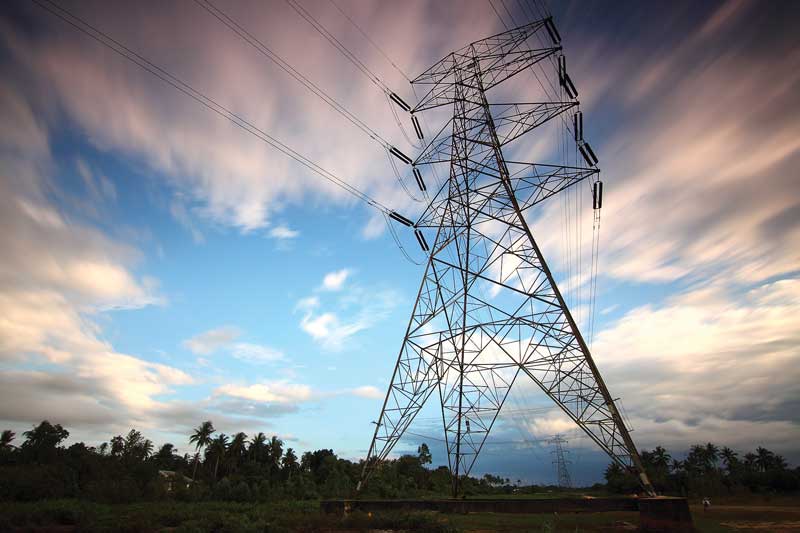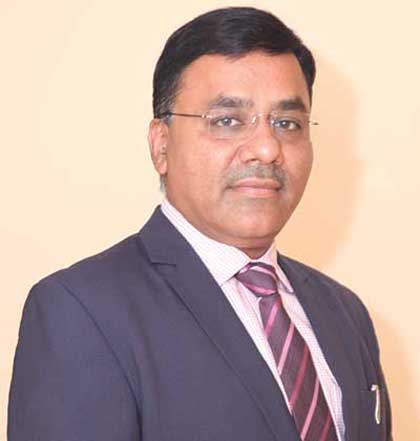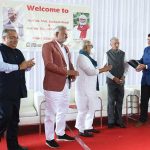“Digitalisation, high-speed communication bandwidth availability, smart equipment which can self-diagnose and report, use of artificial intelligence techniques and machine learning help grid operators to be well informed on a real time basis for better decision making, increase the utilisation of the existing network capacities and optimise losses.”
India witnessed significant reforms in the Power Transmission & Distribution sector in recent years. The government’s focus on attaining ‘Power for all’ has accelerated capacity addition in the country. Keeping in view the current scenario of India’s power sector — particularly the T&D segment and its potential growth, Wire & Cable India interviewed Mr. Manish Agarwal, CEO – Infrastructure and Solutions Business, Sterlite Power Transmission Ltd. to know more about the business highlights of the company, new technologies and potential growth drivers for demand in the segment. Sterlite Power Transmission Ltd. is known to be a leading integrated power transmission developer and solutions provider globally, focused on addressing complex challenges in the sector by tackling the key constraints of time, space, and capital.
Wire & Cable India: What is your take on the government’s policy to reform the power transmission sector?
Manish Agarwal: India is accelerating to meet its bold target of 500 GW by 2030, as committed by the Honourable PM Narendra Modi at COP 26, late last year.
Reforms have been a strong focus area and the government has been nimble in addressing emerging challenges. Going forward, the robust development of the transmission sector will be crucial to meeting India’s Renewable Energy (RE) ambitions in a timely and sustainable manner.
Private Sector Participation: Private sector participation needs to be encouraged into the sector. Transmission infrastructure must be developed only through the competitive bidding route, as it has been observed that when projects are awarded through competitive bidding, tariff discovery is lower by 30-40 percent compared to a traditional cost-plus model. This, in turn, benefits the consumer due to a reduction in transmission charges. To date, Interstate Transmission Systems (ISTS) projects worth USD 13.3 billion have been executed in India. Deepening private sector participation will ensure faster project execution, encourage competition, and provide the industry access to the latest and most relevant cutting-edge technologies. It will also pave the way for new sources of funding. The government is also seeing value in this and has reconstituted its committees like National Committee on Transmission (NCT) and Regional Power Committees-Transmission Planning (RPCTPs) for faster decision making. Prospects also look promising with clear visibility of a pipeline of INR 65,000 crore over the next 2-3 years.
Honourable PM Narendra Modi’s ‘Gati Shakti’ plan is a transformative approach for economic growth and sustainable development. The approach is driven by seven engines, namely, roads, railways, airports, ports, mass transport, waterways, and logistics infrastructure. All seven engines will pull forward the economy in unison. These engines are supported by the complementary roles of energy transmission, IT communication, bulk water & sewerage, and social infrastructure.
System Strengthening: As we add large RE generation capacities and develop evacuation infrastructure, there is pressure on system operators to maintain grid stability and reliability. The intermittency of RE’s variable supply creates an urgent need to strengthen and promote grid interconnections at a regional level.
Energy Storage: There is increased focus from the government on promoting additional energy storage services to the Indian grid. Large tenders for procurement of grid-scale energy storage services are in the works from SECI and NTPC, totalling 4000 MWh. MoP clarified some open issues regarding the use of energy storage across the value chain via its notification dated 29.01.2022. Going forward, the government will need to ensure that the targeted uptake of energy storage technologies does not get stuck. To achieve this, just like ISTS charges waiver was extended to energy storage systems, other applicable benefits such as taxation and accelerated depreciation benefits that are available for RE need to be extended to energy storage projects as well. The government’s recommendation to implement a uniform slab of 5 percent GST on clean energy technologies across the country is also a positive move.
CEA Guidelines on technology and design: RFPs for construction of transmission lines should only specify technical performance matrix, instead of specifying materials and designs. Currently, the construction of transmission lines is mandated to follow design and technology prescriptions. This often does not leave room for the adoption of new and relevant technologies. This constraint increases the asset’s CAPEX due to a spike in per unit tariff. Embracing internationally recognized & established solutions & technologies will enable power transmission to become reliable and cost-efficient. A change in Central Electricity Authority’s (CEA’s) technical regulations to a more accommodative stance will go a long way in helping the industry in this regard. For example, in countries like Brazil, bidders have enough freedom to design and develop the project by adhering to the minimal technical and performance requirements as per the Grid Code and other specific requirements per the bidding documents. The bidding document provides voltage rating, switching schemes, land area dimensions for the substations, the Surge Impedance Loading (SIL) and losses for lines, the maximum reactance, reference corridor, and length, etc. The Bidder, however, is free to decide on the position and layout of substations, the equipment to be installed, the civil design, communication and supervision systems, cable definition, tower structure, routing, span, and tower spotting, civil and foundation designs for the towers.
General Network Access (GNA): The draft GNA proposal, which is under consideration, has the potential to considerably improve transmission planning by Utilities to enable them better access to demand projections. GNA which is open access to the inter-state transmission system can go a long way in safeguarding transmission network availability to Discoms and Generators as per their requirements. Planning can be done in a way such that it doesn’t weigh on the growth of different regions. A sharing regulation or GNA regulation mechanism is desirable in cases where there is no contract signed between transmission licenses and defaulting entities, whose system is delayed. Transmission charges should be recovered through the Point of Connection (PoC) pool irrespective of delay of associated generation or upstream or downstream transmission elements.
- With GNA, Transmission planning will be less ad-hoc and better projected. Network will be available for any new Designated Interstate Customer (DIC) in the country.
- Entities can freely apply for GNA without concern for locking land, financial closure etc.
- Connecting entities will not be required to submit target injection region as planning will be done to ensure adequate transmission availability for all DICs to inject or draw from any region.
Intercontinental Grids: Intercontinental Grids (ICGs) are crucial to a low carbon sustainable energy regime. ICGs will encourage sharing of world energy resources, strengthen power systems, and encourage regional energy cooperation. There is a massive opportunity for India with the ‘One Sun, One World, One Grid’ concept, to be at the forefront with this initiative as a country that has immense potential to generate renewable power.
Watch: Wire & Cable Industry Year Review
WCI: What are the significant business highlights of the company during the past year?
MA: As an organisation, we are guided by our core purpose, ‘Empowering humanity by addressing the toughest challenges of energy delivery’. This spirit is seen in all our project works, which are driven by innovation, execution, and engineering excellence. It keeps us going during the toughest of times to deliver value to the customer and keep lights on in homes across the country. A few key accomplishments that we are particularly proud of this year include:
- We are bringing reliable and quality power to the people of the Northeast, with the critical Northeast Region Strengthening Scheme (NER II). The states of Assam, Arunachal Pradesh, and Tripura, have all been positively impacted with 24/7 electricity due to this project.
- We won the Nangalbibra-Bongaigaon inter-state power transmission project for system strengthening last year. This project will provide more than 1000 MW of power carrying capacity, providing long term solution towards meeting the increasing power demand in western parts of Meghalaya. These lines will also be enhancing the reliability of power supply and help decongesting transmission lines connected with Agia substation in Assam.
- The Lakadia Vadodara Transmission Project Ltd (LVTPL), is part of India’s Green Energy Corridor (GEC) is nearing completion. This is a project for Transmission System strengthening to relieve over loadings in Gujarat Intra-state system due to RE injections in Bhuj substation. Upon completion of this project both Western & Eastern Gujarat will be impacted positively with reliable and quality power, along with parts of Madhya Pradesh and Maharashtra.
- Our Master Systems Integration (MSI) business has entered new states including Gujarat, Manipur, Nagaland, Sikkim, Arunachal Pradesh, and Assam on various projects involving Brownfield uprate/upgrade and fiberisation on existing transmission lines.
- We are at the forefront of offering efficient and effective long span river crossing solutions. After our innovative solution got deployed across the mighty Ganga, we also recently implemented yet another river crossing solution, this time for Madhya Pradesh utility. The solution involved stringing of a span length of 1075 mts across the river Narmada, on a 220 kV Dc line
- EHV UG Business is poised for tremendous growth in India with the thrust to infrastructure sector by the Government of India. Specific push for the Metro Rail in Tier-2 cities, smart cities development & Development of Industrial Zone is fuelling this growth. With the inclusion of lead sheathed cable in our portfolio and successful completion of Product Quality (PQ) Test, we have been able to work with new transmission utilities for underground cable business including Uttar Pradesh (UP), Madhya Pradesh (MP), Maharashtra etc. Our win in the 220kV segment with Maharashtra utility wherein we participated for first time post PQ Test completion will pave the way for our future business in 220kV segment.
- We have a strong leadership position in the High-Performance Conductors (HPC) business segment. Many of our offerings are also oriented towards the RE segment. In OPGW, we offer solutions upto 96 fibre, for high data transfer and communications. For exports, we have a high focus on Europe and Americas. Internationally, we will be laying special emphasis on solutions towards RE that promote decarbonisation.
- I am also delighted to share that our Eco Max conductor technology, an innovation aimed specifically at reducing transmission losses in the RE segment has been recognised with a Platinum Award at the India Smart Grid Forum (ISGF) 2022 awards.
WCI: Highlight new and promising technologies in the T&D segment.
MA: Technology is enabling the transition from large-scale centralised dispatchable power model, to a cleaner, decentralised and consumer-centric model.
Digitalisation, high-speed communication bandwidth availability, smart equipment which can self-diagnose and report, use of artificial intelligence techniques, machine learning, all of these are helping grid operators to be well informed on a real-time basis for better decision making, increase the utilisation of the existing network capacities and optimise losses.
Similarly, the adoption and large-scale implementation of energy storage technologies are also imperative for the Indian Grid. Independent Energy Storage parks at key locations in the Grid can serve as a game-changer for dealing with RE or Grid fluctuations from a wider perspective, as compared to a pure IPP or pure DISCOM perspective. Their utilisation and return of investment could come much faster when they serve multiple constituents of the Grid for multiple purposes.
Over the years, Sterlite Power has set new benchmarks in the industry, with the use of cutting-edge technologies to deliver some of the toughest power transmission projects sustainably, in record timelines. Some of the technology-led innovative measures that we have used/are currently using are:
- Vertical gas-insulated switchgear (GIS) substations been built on 3.8 acres in Gurgaon, saving 75 percent of land size needed as in the case of conventional substation of similar capacity. The government can consider the advantage of building such substations when it comes to saving on land and RoW in congested cities
- Aerial technologies including helicrane-based tower erection, helicopter and drone stringing
- Satellite imagery and machine learning-driven software to optimise transmission line routes
- Uprate and upgrade projects aimed at helping the state governments to transform traditional energy delivery networks with Multi Circuit Multi Voltage (MCMV) towers, micro piles for tower foundations, monopoles instead of lattice
- Sterlite Power recently won the IDC Industry Innovation Awards (IDCIIA) 2021 in the Innovation in Data Intelligence category. The award was for our in-house developed geographic information system-based intelligent route mapping and survey with TransAnalyst and CanvasR. This technology solution improves survey reliability and route generation accuracy and reduces the time for route generation. It also enables data-based decisions, thereby helping reduce project execution timelines.
- High Performance Conductor (HPC) technology is an ‘environmentally friendly’ & cost-effective solution to retrofit existing brownfield infrastructure and augment capacity, using the same corridor footprint, without taking up any additional land or space. Hence, it is crucial, that transmission system planning & philosophy optimize additional capacity by augmenting transmission systems.

WCI: What are the key issues and challenges faced in the T&D segment?
MA: One of the biggest challenges for RE integration is that huge generation capacities are being added much faster than evacuation systems can be built. Transmission systems should be planned ahead of generation. Developing power transmission infrastructure is a bigger challenge as compared to RE power generation, as the transmission is a linear project, crisscrossing innumerable districts, habitats, and regions. RE-rich zones, with high solar insolation and wind speeds with abundant and economical land parcels, are all located away from the load centres. The challenge then is to build transmission lines that consume the least right of way, commissioned in matching time frames of RE projects, and with the availability of efficient capital resulting in the least cost of supply. Solutions are available to build lines with higher line capacities at higher voltages, using lesser RoW, and for enabling faster execution of projects e.g., by use of aerial technologies in construction. Through a conductive policy & regulatory framework which is open to new technology adoption, it is possible to accelerate the adoption of these solutions and get better results. Delays in getting forest approval and clearances need to be addressed. Getting States to support ISTS projects where they do not see any advantage for transmission lines unless the state itself benefits from additional power is also an issue in obtaining clearances.
It is the responsibility of all stakeholders to not only plan well but also to make sure that projects get commissioned as per the plan on time. Finally, retrofitting existing transmission infrastructure and augmenting capacities is an environmentally friendly solution that can be done in a timely and cost-effective manner as these do not require additional space/RoW.
WCI: What do you think will be the potential growth drivers for demand in the T&D segment in the coming years?
MA: Integration of upcoming generation within States & capacity addition from ISTS: India’s ambitious RE goals require Transmission Infrastructure to be built at ISTS level ahead of time in line with the short gestation period of RE projects. Power demand is estimated to increase by 41 percent (from 190 GW to 267 GW) while generation capacity is envisaged to increase by 34 percent (395 GW to 528 GW), by the year 2024-25. In this context, the transmission sector has visibility of projects worth ~INR 30,000 crores to be auctioned under TBCB in FY23 and another ~INR 35,000 crores in FY24. Beyond this as well, there is ongoing planning for ~ 181 GW of RE pockets in several states by MNRE and SECI. CTU & CEA would further be planning linked transmission infra for evacuating these projects at ISTS level which further will give an opportunity of~ INR 76,000 crores at ISTS level, from FY25 onwards.
States will need to invest in upgrading their transmission infrastructure to integrate RE Installations and several GEC (Green Energy corridors) with transmission lines length of 10,750 ckm & Sub-stations of 27,500 MV ) – for which CCEA has already approved an investment of INR ~12,031 Cr across 7 States to be implemented in next 5 years (2021-22 to 2025-26).
The intrastate segment is also showing promising signs of implementing transmission projects in TBCB mode. States like UP, MP, and Rajasthan have already initiated/executed transmission bids under TBCB mode. In addition, the following measures taken will have a positive impact in solving the challenges faced by the sector at a state level.
State utilities will also invest in measures to upgrade and augment intra-state transmission as well as sub-transmission networks e.g., RDS (Revamping of Distribution Sector) scheme with an outlay of 3.03 lakh crores
The govt. has also proposed to transfer 33 kV networks from DISCOMs to STUs in a phased manner for upgradation and modernisation.
Another key driver will be ISTS waivers on all RE projects, BESS as well as for captive consumption. This has enabled further pick up in transmission.





